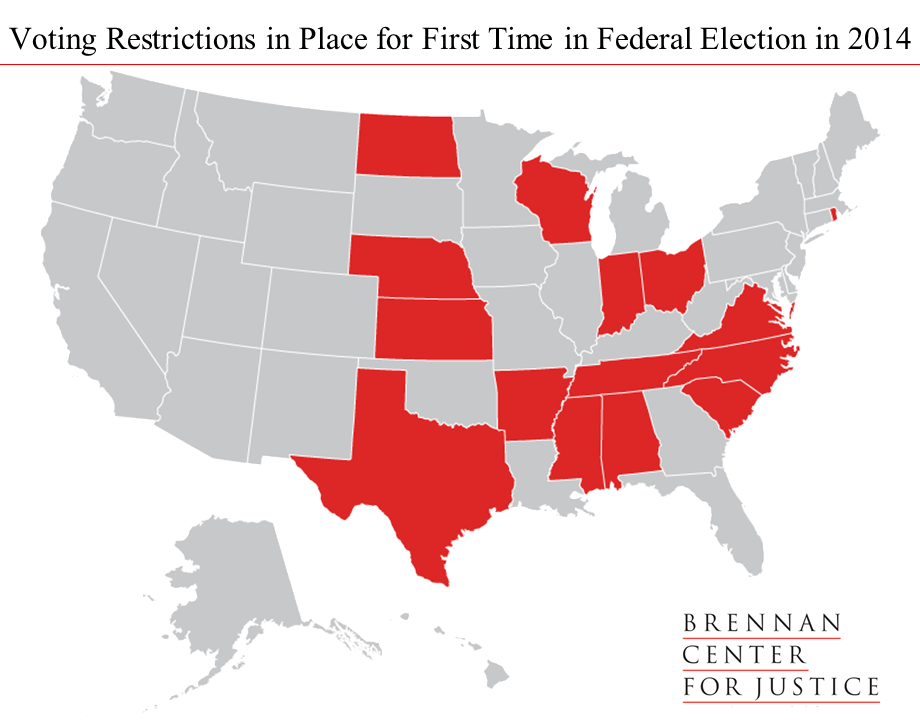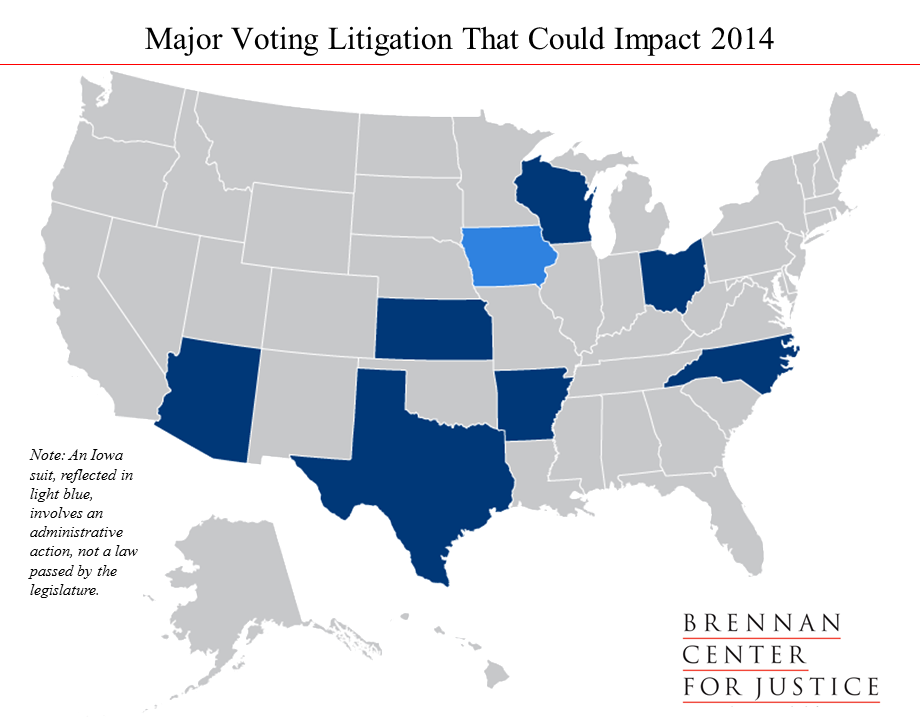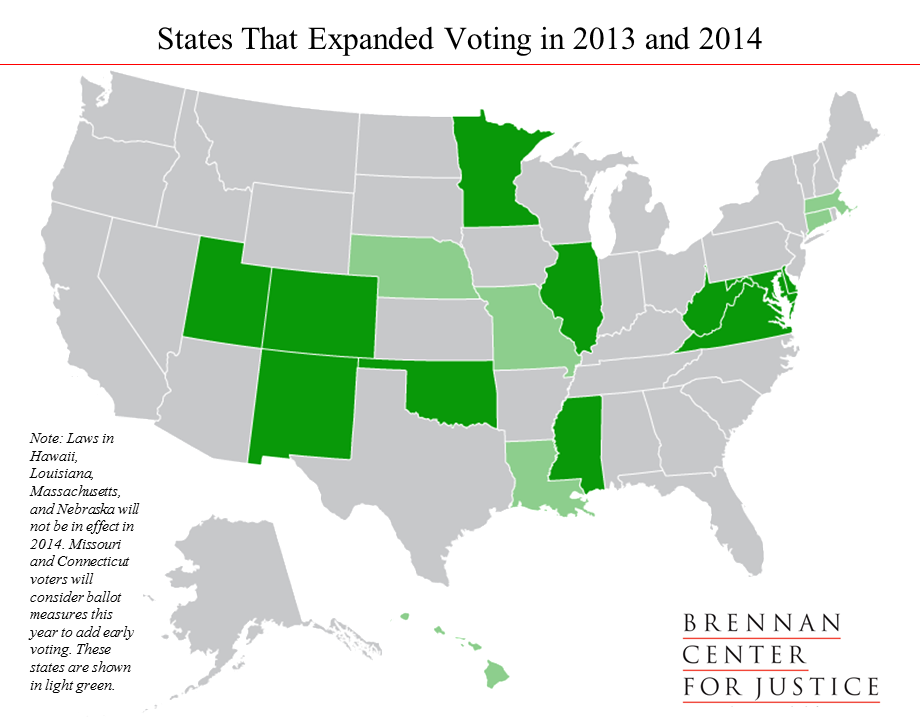See all of the Brennan Center’s 2014 voting resources.
Executive Summary
As we approach the 2014 election, America is still in the midst of a high-pitched and often highly partisan battle over voting rights. On one side are politicians passing laws and executive actions that would make it harder for many citizens to vote. This started after the 2010 midterm elections, when new state legislative majorities pushed a wave of laws cracking down on voting. On the other side are groups of voters and advocates pushing back — in the legislatures, at the ballot box, and especially in the courts.
Until recently, the Voting Rights Act was a critical tool in the fight, but the U.S. Supreme Court gutted the law’s core protection last year. Since then, a number of states moved forward with controversial voting changes, including those previously blocked under the Voting Rights Act. As most state legislative sessions wind down, the focus shifts to activity in the courts, which are currently considering major challenges to new restrictions across the country.
In short, many Americans face an ever-shifting voting landscape before heading to the polls this November.
In advance of this crucial midterm election, this report details the new voting restrictions put in place over the past few years, the laws that are in place for the first time in 2014, and the major lawsuits that could affect this year’s elections. Our key findings include:
- Since the 2010 election, new voting restrictions are slated to be in place in 22 states. Unless these restrictions are blocked — and there are court challenges to laws in six of those states — voters in nearly half the country could find it harder to cast a ballot in the 2014 midterm election than they did in 2010. The new laws range from photo ID requirements to early voting cutbacks to voter registration restrictions. Partisanship and race were key factors in this movement. Most restrictions passed through GOP-controlled legislatures and in states with increases in minority turnout.
- In 15 states, 2014 will be the first major federal election with these new restrictions in place. Ongoing court cases could affect laws in six of these states.
- The courts will play a crucial role in 2014, with ongoing suits challenging laws in seven states. Voting advocates have filed suits in both federal and state courts challenging new restrictions, and those suits are ongoing in seven states — Arizona, Arkansas, Kansas, North Carolina, Ohio, Texas, and Wisconsin. There is also an ongoing case in Iowa over administrative action that could restrict voting. More cases are possible as we get closer to the election.
There has also been some positive momentum. Laws to improve the election system and increase voting access passed in 16 states since 2012, and these laws will be in effect in 11 states this November. The most common improvements were online registration and other measures to modernize voter registration, and increased early voting.
Still, this national struggle over voting rights is the greatest in decades. Voters in nearly half the country could head to the polls in November worse off than they were four years ago. This needs to change.
New Laws Restricting the Vote
Election laws have long been prone to politicization, but for decades there were no major legislative movements to restrict voting. Indeed, the last major legislative push to cut back on voting rights was after Reconstruction. The first stirrings of a new movement to restrict voting came after the 2000 Florida election debacle. Indiana and Georgia passed restrictive photo ID laws in 2005 and 2006, respectively, and Arizona voters approved a ballot initiative in 2004 requiring registrants to provide documentary proof of citizenship when signing up.
But the 2010 election marked a major shift. From early 2011 until the 2012 election, state lawmakers across the country introduced at least 180 restrictive voting bills in 41 states. By the 2012 election, 19 states passed 27 restrictive voting measures, many of which were overturned or weakened by courts, citizen-led initiatives, and the Department of Justice before the election. States continued to pass voting restrictions in 2013 and 2014.
What is the cumulative effect of this legislative movement? As of now, a few months before the 2014 midterm elections, new voting restrictions are set to be in place in 22 states.[1] Ongoing court cases could affect laws in six of these states.[2] Unless these restrictions are blocked, citizens in nearly half the nation could find it harder to vote this year than in 2010.
Click for interactive version.
Partisanship played a key role. Of the 22 states with new restrictions, 18 passed entirely through GOP-controlled bodies,[4] and Mississippi’s photo ID law passed by a voter referendum. Two of the remaining three states — Illinois and Rhode Island — passed much less severe restrictions. According to a recent study from the University of Massachusetts Boston, restrictions were more likely to pass “as the proportion of Republicans in the legislature increased or when a Republican governor was elected.”
Race was also a significant factor. Of the 11 states with the highest African-American turnout in 2008, 7 have new restrictions in place.[5] Of the 12 states with the largest Hispanic population growth between 2000 and 2010, 9 passed laws making it harder to vote.[6] And nearly two-thirds of states — or 9 out of 15 — previously covered in whole or in part by Section 5 of the Voting Rights Act because of a history of race discrimination in voting have new restrictions since the 2010 election.[7] Social science studies bear this out. According to the University of Massachusetts Boston study, states with higher minority turnout were more likely to pass restrictive voting laws. A University of California study suggests that legislative support for voter ID laws was motivated by racial bias.
What do these laws look like?
- Voter ID: A total of 13 states passed more restrictive voter ID laws between 2011 and 2014, 11 of which are slated to be in effect in 2014.[8] Nine states passed strict photo ID requirements,[9] meaning a citizen cannot cast a ballot that will count without a specific kind of government-issued photo ID. An additional four states passed less strict ID requirements.[10] Eleven percent of Americans do not have government-issued photo ID, according to a Brennan Center study, which has been confirmed by numerous independent studies. Research shows these laws disproportionately harm minorities, low-income individuals, seniors, students, and people with disabilities. In Texas, for example, early data from the state showed that between 600,000 and 800,000 registered voters did not have the kind of photo ID required by the state’s law, and that Hispanics were 46 to 120 percent more likely to lack an ID than whites. In North Carolina, estimates show that 318,000 registered voters — one-third of whom are African American — lack a DMV-issued ID.[11]
- Voter Registration: A total of nine states passed laws making it harder for citizens to register to vote between 2011 and 2014.[12] These measures took a variety of forms. Four states[13] have new restrictions on voter registration drives. Nationally, African Americans and Hispanics register through drives at twice the rate as whites.[14] Three states[15] also passed laws requiring registrants to provide documentary proof of citizenship, which as many as 7 percent of Americans do not have readily available. North Carolina eliminated highly-popular same-day registration, and Wisconsin made it harder for people who have moved to stay registered.
- Early Voting: Eight states passed laws cutting back on early voting days and hours.[16] These restrictions could exacerbate lines on Election Day and are particularly likely to hurt minority voters. For example, in North Carolina, Department of Justice data show that 7 in 10 African Americans who cast ballots in 2008 voted during the early voting period, and 23 percent of them did so during the week that was cut. Many states eliminated weekend and evening hours, when minority voters are more likely to cast a ballot. According to a study in Ohio in 2008, 56 percent of weekend voters in Cuyahoga County, the state’s most populous, were black.
- Restoring Voting Rights to People with Past Convictions: Three states also made it harder to restore voting rights for people with past criminal convictions.[17] These laws disproportionately impact African Americans. Nationwide, 7.7 percent of African Americans have lost the right to vote, compared to 1.8 percent of the rest of the population.
What’s New in 2014
In 15 states,[18] 2014 will be the first major federal election with new voting restrictions in place. Ongoing court cases could affect laws in six of these states.[19] The uncertainty over these laws could lead to problems on Election Day, as they did in 2012, when voting changes, even those not in effect, contributed to long lines.[20] We have already seen problems with new ID requirements in low-turnout primaries, such as in Arkansas this May, which could foreshadow more serious problems in November.

Lawsuits Over Voting Restrictions
Voter advocates are fighting many of these new restrictions, especially in court. Voting restrictions are currently being challenged in court in seven states — Arizona, Arkansas, Kansas, North Carolina, Ohio, Texas, and Wisconsin. A lawsuit over a voter purge is also ongoing in Iowa. Most of the cases we are watching this year will likely be decided, at least preliminarily, in the coming months and could thus impact the 2014 election.
Click for interactive version.
Challenges to restrictive voting laws have had a successful track record to date. Before the 2012 election, 10 courts blocked new restrictions in at least 7 states.[21] Some of those legal fights continued into this year — in Pennsylvania (where a case challenging a strict new photo ID requirement is now over after the governor chose not to appeal a ruling against the law), in Texas (where a court found the state’s voter ID law discriminatory under Section 5 of the Voting Rights Act, but then the Supreme Court effectively invalidated Section 5, prompting a new lawsuit challenging the same voter ID law under a different legal provision), and in Arizona (where the Supreme Court ruled against the state’s new documentary proof of citizenship requirement for voter registration but left room for the state to sue again to seek a different result).
Over the past few years voters have won decisively in Pennsylvania on voter ID; in Florida on voter registration restrictions, early voting cutbacks, and a voter purge; in Ohio on early voting cutbacks and provisional ballot counting; and in a few cases challenging ballot measure language.
Voters received favorable decisions in ongoing lawsuits in Wisconsin and Arkansas on voter ID and Iowa on voter purges. Voters also won a lawsuit challenging Texas’s voter ID law that is now being re-litigated under a different provision of law after the Supreme Court gutted a key provision of the Voting Rights Act.
Voters have also experienced losses — in Tennessee on voter ID, in Texas on voter registration drive restrictions, and in South Carolina on voter ID (though during the course of the litigation, the state interpreted the law in a way that was much less restrictive). All of those laws are in place this year.
Improving Voting Access
There has also been some positive momentum to improve voting.
After long lines marred the 2012 election, dozens of states introduced legislation in 2013 and 2014 to improve access to the polls. Overall, laws to improve the voting process passed in 16 states, and are set to be in effect in 11 states this November.[22] Five of these states also passed voting restrictions.[23]
Click for interactive version.
What do these laws look like?
- Voter Registration Modernization: A total of 11 states passed laws to modernize the voter registration system and make it easier for eligible citizens to sign up.[24] (A number of states, like New York, implemented reforms administratively and are not reflected here.) Research shows these upgrades can increase registration rates, efficiency, and accuracy, save money, and curb the potential for fraud.
- Early Voting: Three states expanded or created early voting opportunities[28], which can reduce stress on the voting system, lead to shorter lines on Election Day, and improve poll worker performance, among other benefits. Massachusetts’s law will not be in effect until 2016. Missouri and Connecticut voters will also consider ballot measures to create early voting periods.
- Pre-Registration: Three states passed laws allowing 16– and 17-year-olds to pre-register to vote before turning 18.[29]
- Restoring Voting Rights to People with Past Convictions: Delaware passed a constitutional amendment expanding opportunities for people with criminal convictions to regain their right to vote.
- Easing Voter ID Burdens: Oklahoma passed a law making its existing photo ID law less restrictive.
- Access to Ballots: Colorado expanded access for voters who speak a language other than English. Mississippi and Oklahoma also expanded access to absentee ballots.
There was also movement on the national level. The bipartisan Presidential Commission on Election Administration released a widely-praised set of recommendations to fix many of the problems persistently plaguing the voting system. These ideas included modernizing voter registration and increasing early voting opportunities. A few states — Hawaii, Illinois, Nebraska, Massachusetts, and Minnesota — adopted some of these reforms in 2014. And in Congress, Republicans and Democrats introduced a bill to strengthen the Voting Rights Act. Unfortunately, that measure appears stalled. Democrats in Congress also introduced a host of bills to modernize the voting system, reduce long lines, and increase access to the polls.
[1] Alabama, Arkansas, Florida, Georgia, Illinois, Indiana, Iowa, Kansas, Mississippi, Nebraska, New Hampshire, North Carolina, North Dakota, Ohio, Rhode Island, South Carolina, South Dakota, Tennessee, Texas, Virginia, West Virginia, and Wisconsin. For a detailed description of each state’s laws, see our interactive map or this list.
[2] Arkansas, Kansas, North Carolina, Ohio, Texas, and Wisconsin. There is also a challenge to an Arizona law not reflected here because that law passed before 2010.
[3] Montana lawmakers put a referendum on the November ballot to repeal Election Day registration, but that repeal will not actually be in effect this year. An Arizona law requiring documentary proof of citizenship when registering was passed in 2004, but blocked in 2012 for a voter using the federal registration form. In response, Arizona joined Kansas, which has a similar law, in a suit to force the U.S. Election Assistance Commission (EAC) to change the federal form to allow the two states to require such documents. In March 2014, a federal judge ruled the EAC must change the form, but the 10th Circuit Court of Appeals stayed that decision while it considers the appeal. Arizona is included here because until now, the federal form has never been amended to allow for documentary proof of citizenship in any state.
[4] By GOP-controlled body, we mean: (1) Both chambers of the legislature were controlled by Republicans and a Republican governor signed the bill, (2) Republicans controlled both chambers and overrode a veto from a Democratic governor, or (3) a Republican governor took executive action without legislative involvement. States in the first category were Alabama, Florida, Georgia, Indiana, Kansas, Nebraska (unicameral legislature with GOP governor), North Carolina, North Dakota, Ohio, South Carolina, South Dakota, Tennessee, Texas, Virginia (the GOP lieutenant governor broke a tie between an equally divided Senate), and Wisconsin. States in the second category were Arkansas and New Hampshire. Iowa and Florida fall into the third category.
[5] Mississippi (73.1 percent), South Carolina (72.5), Wisconsin (70.5), Ohio (70.0), Georgia (68.1), North Carolina (68.1), and Virginia (68.1). Source: U.S. Census Bureau, Voting and Registration in the Election of November 2008 – Detailed Tables, Table 4b (Reported Voting and Registration of the Voting-Age Population, by Sex, Race and Hispanic Origin, for States: November 2008) http://www.census.gov/hhes/www/socdemo/voting/publications/p20/2008/tables.html.
[6] South Carolina (148 percent growth), Alabama (145), Tennessee (134), Arkansas (114), North Carolina (111), Mississippi (106), South Dakota (103), Georgia (96), and Virginia (92). Source: Pew Hispanic Center tabulations of U.S. Census Bureau Redistricting_Files-PL_94–171 for states http://www.pewhispanic.org/files/reports/140.pdf.
[7] Alabama, Florida (partially covered), Georgia, Mississippi, North Carolina (partially covered), South Carolina, South Dakota (partially covered), Texas, and Virginia.
[8] Alabama, Arkansas, Kansas, Mississippi, New Hampshire, North Carolina, North Dakota, Rhode Island, South Carolina, Tennessee, Texas, Virginia, and Wisconsin. The North Carolina law will not be in effect for 2016, and the Wisconsin law was blocked by the courts in ongoing litigation. Some of these states passed more than one voting restriction and thus appear in other categories as well.
[9] Alabama, Arkansas, Kansas, Mississippi, North Carolina, Tennessee, Texas, Virginia, and Wisconsin. The North Carolina law will not be in effect for 2016, and the Wisconsin law was blocked by the courts in ongoing litigation.
[10] A photo ID is requested in New Hampshire, Rhode Island, and South Carolina, but there is an affidavit alternative. A non-photo ID is required in North Dakota.
[11] A study from the North Carolina Board of Elections estimates 318,643 registered voters lack a DMV-issued photo ID. Approximately one-third of that total (107,681) are African American. Available here: http://moritzlaw.osu.edu/electionlaw/litigation/documents/League1591.pdf.
[12] Alabama, Florida, Illinois, Kansas, North Carolina, Tennessee, Texas, Virginia, and Wisconsin. Due to an error, Nebraska was previously included in this list. It was updated and removed on October 9, 2014.
[13] Florida, Illinois, Texas, and Virginia.
[14] Voting Law Changes in 2012, at 20 & 48 (2011), available at http://www.brennancenter.org/sites/default/files/legacy/Democracy/VRE/Brennan_Voting_Law_V10.pdf; State Restrictions on Voter Registration Drives, at 3 & 9 (2012), available at http://www.brennancenter.org/sites/default/files/legacy/publications/State%20Restrictions%20on%20Voter%20Registration%20Drives.pdf.
[15] Alabama, Kansas, and Tennessee. The Kansas law is only in effect for the state registration form. Alabama and Tennessee election officials have yet to implement their state’s laws.
[16] Florida, Georgia, Nebraska, North Carolina, Ohio, Tennessee, West Virginia, and Wisconsin.
[17] Florida, Iowa, and South Dakota.
[18] Alabama, Arkansas, Indiana, Kansas, Mississippi, Nebraska, North Carolina, North Dakota, Ohio, Rhode Island, South Carolina, Tennessee, Texas, Virginia, and Wisconsin.
[19] Arkansas, Kansas, North Carolina, Ohio, Texas, and Wisconsin. There is also a challenge to an Arizona law not reflected here because that law passed before 2010.
[20] How to Fix Long Lines, at 4 (2013), available at http://www.brennancenter.org/sites/default/files/publications/How_to_Fix_Long_Lines.pdf.
[21] Arizona, Florida, Missouri, Ohio, Pennsylvania, Texas, and Wisconsin.
[22] Laws in Colorado, Delaware, Illinois, Maryland, Minnesota, Mississippi, New Mexico, Oklahoma, Utah, Virginia, and West Virginia are slated to be in effect in 2014. Measures in Hawaii, Louisiana, Massachusetts, and Nebraska will be in effect at a later date. Missouri voters will consider a ballot measure this November. Connecticut citizens will also vote on an early voting ballot measure this year, but that bill passed prior to 2013 and is not included in this count. For a detailed description of each state’s laws, see our interactive map or this list.
[23] Illinois, Nebraska, Mississippi, Virginia, and West Virginia.
[24] Colorado, Hawaii, Illinois, Maryland, Massachusetts, Minnesota, Nebraska, New Mexico, Utah, Virginia, and West Virginia.
[25] Illinois, Massachusetts, Minnesota, Nebraska, Utah, Virginia, and West Virginia.
[26] Colorado, Hawaii, Illinois, Maryland, and Utah. Both Illinois and Utah are pilot programs.
[27] Nebraska and New Mexico.
[28] Illinois, Maryland, and Massachusetts. Illinois’s bill is a pilot program for 2014 only.
[29] Colorado, Louisiana, and Massachusetts.







